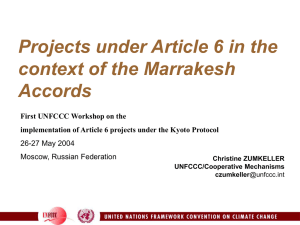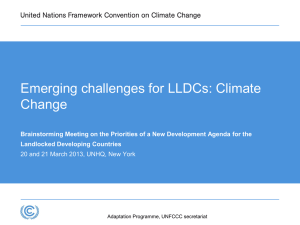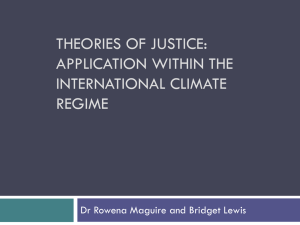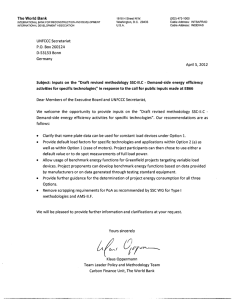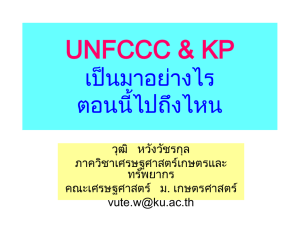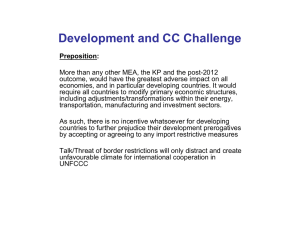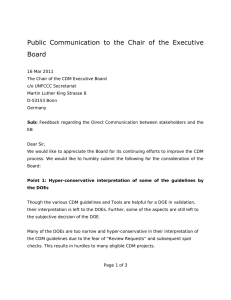Promoting action under the UNFCCC
advertisement
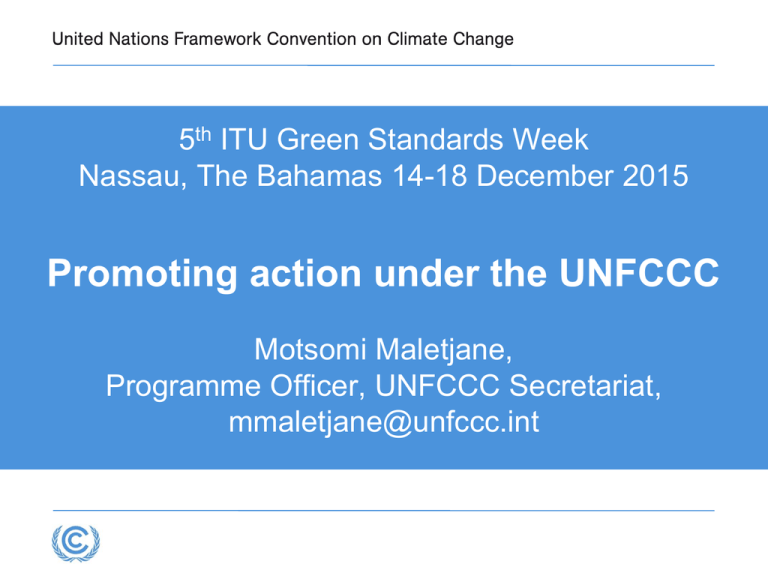
5th ITU Green Standards Week Nassau, The Bahamas 14-18 December 2015 Promoting action under the UNFCCC Motsomi Maletjane, Programme Officer, UNFCCC Secretariat, mmaletjane@unfccc.int Contents 1) The Convention 2) Promoting action 3) Paris Agreement 4) Elements and steps from the national adaptation plans Quick timeline of the UNFCCC 1989: IPCC establish ed 2005: Kyoto Protocol enters into force 1994: UNFCCC enters into force 1992: UNFCCC adopted 2015: Adoption of the Paris Agreeme nt 1998: Kyoto Protocol adopted 2007: Bali Action Plan Complete timeline is available at <http://unfccc.int/timeline> What does the UNFCCC regime do? In order to achieve the objectives of the Convention, governments under the UNFCCC • Gather and share information on GHG emissions, national policies and best practices • Launch national strategies and measures for reducing GHGs and adapting to the adverse impacts of climate change • Develop support (finance, technology, capacity-building) for developing countries • Cooperate in preparation for taking mitigation and adaptation measures Promoting action • In addition to negotiations under its different bodies, the UNFCCC brings together different actors and stakeholders on climate change mitigation and adaptation • Means include: a) Engagement of governments and other different actors and stakeholders to showcase action during the sessions of the COP and its subsidiary bodies, as well as through activities of various bodies and programmes b) Momentum for Change c) Lima-Paris Action Agenda (LPAA) d) Non-State Actor Zone for Climate Action (NACZA) Momentum for change Momentum for Change shines a light on the enormous groundswell of activities underway across the globe that are moving the world toward a highly resilient, low-carbon future Momentum for Change - focus areas • Urban Poor: recognising climate action that improves the lives of impoverished people in urban communities – with support from Bill & Melinda Gates Foundation • Women for results: recognising the critical leadership and participation of women in addressing climate change – with support from Rockefeller Foundation • Financing for climate friendly investment: recognizing successful and innovative climate-smart activities – in partnership with World Economic Forum • ICT solutions: recognizing successful climate change activities in the field of information communication technology - in partnership with Global eSustainability Initiative Lima-Paris Action Agenda (LPAA) • Joint undertaking of the Peruvian and French COP presidencies, the Office of the UN Secretary-General and the UNFCCC Secretariat • Aims to strengthen climate action throughout 2015, in Paris in December and well beyond through: a) Mobilizing robust global action towards low carbon and resilient societies; b) Providing enhanced support to existing initiatives, such as those launched during the NY SG Climate Summit in September 2014 c) Mobilizing new partners and providing a platform for the visibility of their actions, commitments and results in the run up to COP21 Contributing to the LPAA Sub-national actors can engage by… • Committing to GHG reductions, climate planning, climate resilience or taking sectoral commitments • Joining large-scale cooperative and multi-stakeholder initiatives • Setting up new partnerships • Working with States in a vertically integrated approach Join the LPAA Criteria To be included in the LPAA, an initiative must: • Be cooperative, be inclusive, open and regionally balance • Be ambitious: short and long term quantifiable targets – transformative actions guided by a 2°C and resilient pathway. • Be science based: Address a concrete impact of climate change mitigation or adaptation issues to get us on a resilient and below 2°C pathway • Have the capacity to deliver. Ability to directly deliver and implement commitments • Showcase implementation of existing commitments (sufficient level of maturity in Paris) • Follow-up and report. Ready to report on implementation Non-State Actor Zone for Climate Action (NAZCA) • Registers commitments to climate action by companies, cities, subnational regions, and investors to address climate change • Leading cooperative action on NAZCA are the Lima-Paris Action Agenda (LPAA) transformational initiatives, which are accelerating ambition in 2015 and beyond • COP invites non-Party stakeholders to scale up their efforts and support actions to reduce emissions and/or to build resilience and decrease vulnerability to the adverse effects of climate change and demonstrate these efforts via the NAZCA platform (http://climateaction.unfccc.int) Recorded initiatives The LPAA and NAZCA have already captured climate actions and pledges covering: • Over 7,000 cities, including the most vulnerable to climate change, from over 100 countries with a combined population with one and a quarter billion people and around 32% of global GDP • Sub-national states and regions comprising one fifth of total global land area and combined GDP of $12.5 trillion • Over 5,000 companies from more than 90 countries that together represent the majority of global market capitalisation and over $38 trillion in revenue • Nearly 500 investors with total assets under management of over $25 trillion Paris Agreement Article 2 This Agreement, in enhancing the implementation of the Convention, including its objective, aims to strengthen the global response to the threat of climate change, in the context of sustainable development and efforts to eradicate poverty, including by: • To limit temperatures well below 2 °C, and pursue efforts to limit the temperature increase to 1.5 °C • Increasing the ability to adapt to the adverse impacts of climate change and foster climate resilience and low greenhouse gas emissions development, in a manner that does not threaten food production • Making finance flows consistent with a pathway towards low greenhouse gas emissions and climate resilient development Paris Agreement Preamble para # 16 • Agreeing to uphold and promote regional and international cooperation in order to mobilize stronger and more ambitious climate action by all Parties and non-Party stakeholders, including civil society, the private sector, financial institutions, cities and other subnational authorities, local communities and indigenous peoples Enhanced action prior to 2020 On enhanced action prior to 2020 • The COP welcomes the efforts of all non-Party stakeholders to address and respond to climate change, including those of civil society, the private sector, financial institutions, cities and other subnational authorities • Invites the non-Party stakeholders to scale up their efforts and support actions to reduce emissions and/or to build resilience and decrease vulnerability to the adverse effects of climate change and demonstrate these efforts via the Non-State Actor Zone for Climate Action platform (http://climateaction.unfccc.int) Steps on the formulation and implementation of national adaptation plans http://unfccc.int/7279 Sample process to formulate and implement a national adaptation plan Note: The figure shows steps and their outputs (in blue) that act as inputs for subsequent steps. Abbreviations: M&E = monitoring and evaluation, NAP = national adaptation plan. Follow the UNFCCC • UNFCCC website: http://unfccc.int • UNFCCC Executive Secretary Christiana Figueres on Twitter: @CFigueres • UNFCCC on Twitter: @UNFCCC | Español: @CMNUCC | Francais: @CCNUCC | Deutsch: @UNKlima • UNFCCC on Facebook: facebook.com/UNclimatechange • UNFCCC on Instagram: @UNFCCC
